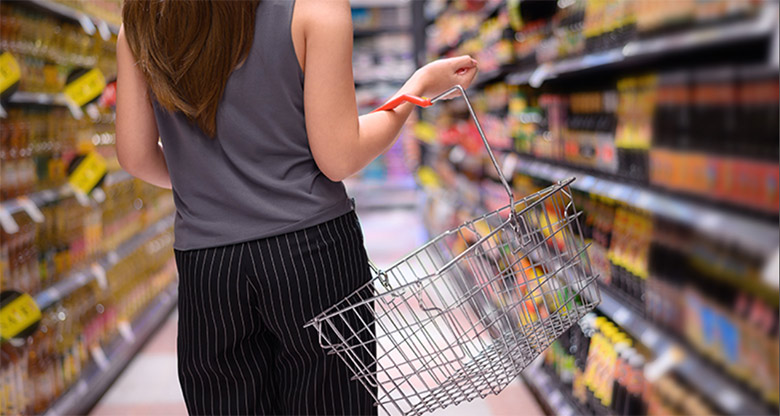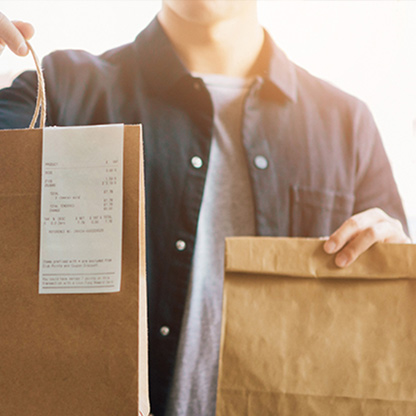In the earliest stages of the coronavirus pandemic, and again more recently in Victoria, shoppers descended on food and liquor stores in a frenzy of panic buying. While sales have since settled from their peaks, the scarcity of everyday items during those periods is likely etched in consumers’ memories.
Unlike other retail categories, food and liquor stores were deemed essential and traded through the various restrictions. And while more consumers used online delivery services, online shopping in the food and liquor category has trailed other sectors. According to CommBank research in January 20201, just over one in two shoppers had purchased from a food and liquor retailer online, the lowest of any category.
With many consumers continuing to shop in-store, food and liquor retailers needed to adjust their operations to protect the health and safety of shoppers and staff. The introduction of guidelines, protective screens, store routing and hand sanitiser followed.
The January 2020 research1 also showed that food and liquor retailers were more likely to have invested in people and the customer experience than any other category over the past five years. This proved vital during the pandemic, where engaged and well-trained staff could help guide cautious shoppers.
For Antoine Rizk, Owner and Director of Mint Fresh IGA, it was a focus on people and the customer experience that allowed his five supermarkets to thrive in recent months. He was able to intimately understand the changing needs of shoppers and service those to a high standard. A focus on understanding customers was also shown by CommBank January 2020 research1 to be common among stronger retailers, and likely to provide prevailing advantages in the face of ever-changing preferences.
Addressing the basics
As consumers clamoured to buy the staples that would see them through the pandemic and spent less time eating out, basic items were highly sought after. This tested the supply chains of the major food retailers, with some even imposing purchasing limits to ensure stock remained available.
Upon polling retailers in January 20201, the findings revealed that product-related factors, including range and differentiation, were among the key focus areas separating stronger and weaker retailers. And Antoine says that amid a surge in demand for affordable staples, having diversity and flexibility in IGA Mint Fresh’s supply chain became a competitive advantage and helped capture new customers.
“While the majors were dealing with out-of-stock items, we had already moved to a model where we could source staples like flour and rice from multiple suppliers. It wasn’t a challenge to diversify our supply chain, in fact, our ability to seek independent suppliers was a huge advantage.”
“We also increased our range dramatically, introducing second- and third-tier brands across key product lines which were turning over much faster than we expected. As a result of our focus on making stock available and enhancing our range, we noticed a substantial uplift in new customers during coronavirus.”
Staying ahead of shopper demand
Ensuring customers were confident in the availability of IGA Mint Fresh’s range remained a focus for Antoine during the pandemic. But it was also having the systems and processes in place to make well-informed decisions that helped satisfy rapidly changing consumer demand and keep new shoppers coming back.
“As we saw new customers during coronavirus, we were tracking buying behaviour at an SKU (stock-keeping unit) level. We assessed the buying habits of new customers, which triggered certain product selections that kept them coming back. We are always reviewing customer data to make sure we are meeting their needs.”
Antoine explains that effective analysis of data relies on combining multiple sources, and is crucial to making swift changes to the operating environment.
“We collect and analyse information from three key sources,” Antoine says. “The first is our point-of-sale data, which can deliver specific details around customers’ product preferences. The second is our store managers, who are speaking directly to customers and feeding back information about what they need and want. Then we look at holistic data that was provided by Metcash and CommBank around consumer habits at a national-, state- and suburb-level.”
Building shopper confidence
The research undertaken in January 20201 showed that 54 per cent of food and liquor retailers considered that their in-store experience had improved over the past five years. However, only 37 per cent of shoppers in the category agreed. Given that many consumers continued to shop in-store during the coronavirus pandemic, creating a positive experience required food and liquor retailers to foster greater confidence and trust.
“We operate in New South Wales and while it isn’t as severe as Victoria, we needed to provide our customers with a heightened sense of comfort and hygiene when they shopped in our stores. We had a seamstress prepare branded re-usable masks for staff, we have a coronavirus marshal in every store, and re-trained our staff in line with our coronavirus safe action plan. We rolled that out well before anyone else.”
“That had a big impact in the community where our staff live, as they spoke to family and friends about the health and safety measures we were taking. That helped build shoppers’ confidence.”
Antoine adds that no matter the external environment, customer service is at the forefront of a good experience and a personable approach helped during coronavirus.
“When a new customer comes in the store, we will greet them, and a store manager may even give them a store tour. We have what we call the ‘3m’ rule where if a customer comes within three metres of a staff member, they have to stop and say hello. It’s these personal interactions which help build trust.”
So, as food and liquor retailers continued to welcome shoppers into stores during the pandemic, it was meeting shoppers’ basic needs that took initial priority, including making staples available and providing a safe environment to shop. In an environment where that has become more challenging, understanding and adapting to customer needs has come to the fore.



